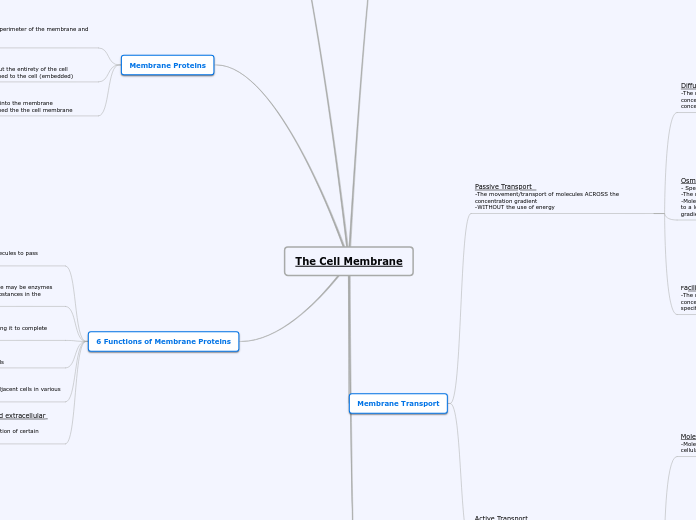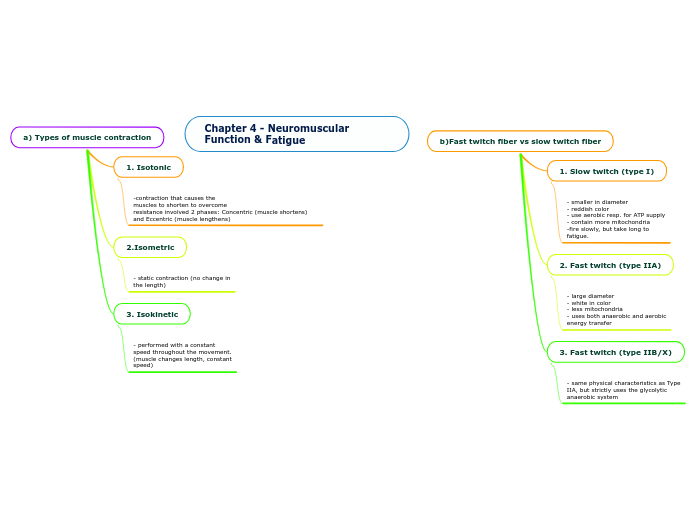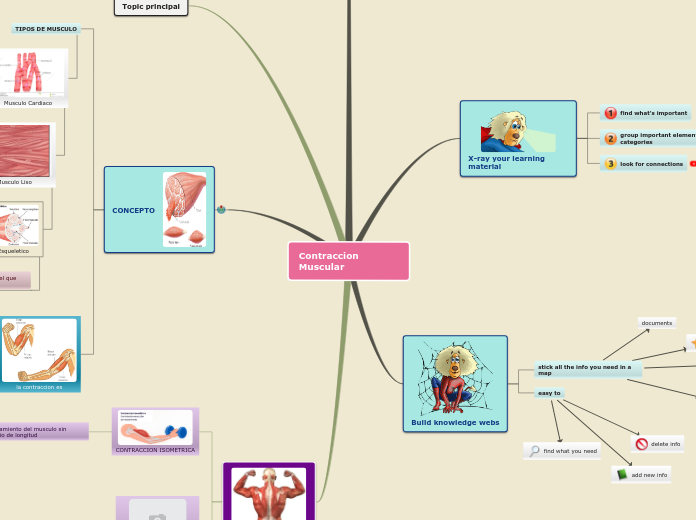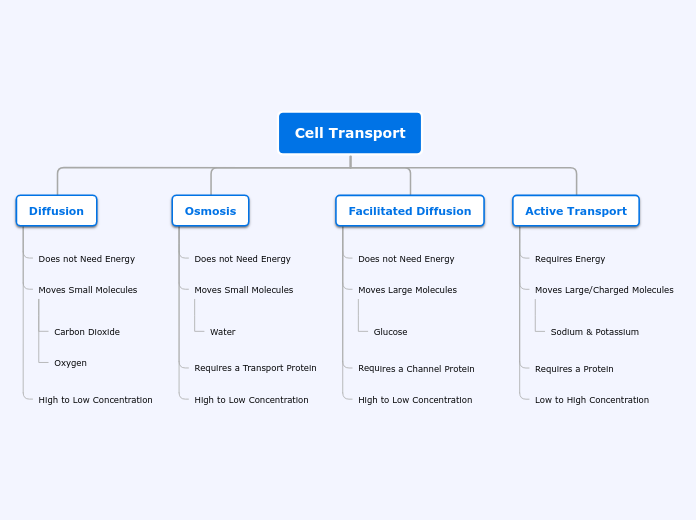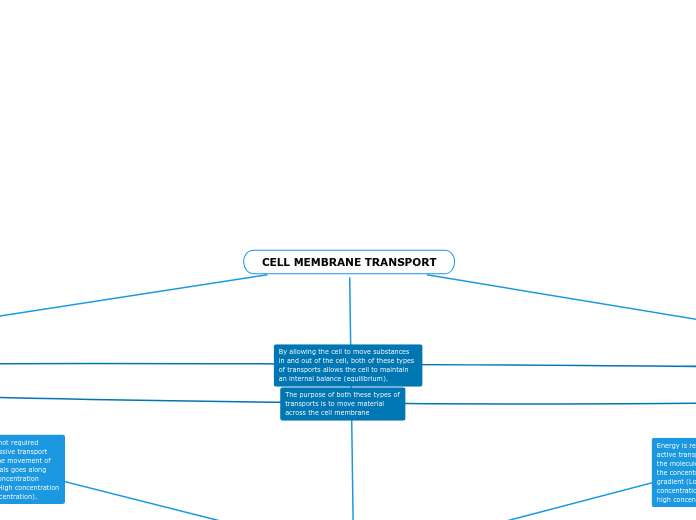The Cell Membrane
Action Potential
-In an axon, the change in charge that occurs when the fates of the K+ close, and the gates of NA+ channels open after a wave of depolarization is triggered.
Resting Membrane Potential -The potential difference across the membrane in a resting neuron
Repolarization -The effect of the sodium-potassium pump and the small amount of naturally occurring diffusion on the cell membrane of a neuron, which returns to its normal resting potential
Depolarization -A process in which the inside of the cell becomes less negatively charged relative to the outside of the cell
6 Functions of Membrane Proteins
Attachment to the cytoskeleton and extracellular matrix (ECM) -help maintain cell shape and fix the location of certain membrane proteins
Intercellular Joining -Proteins that connect with proteins of adjacent cells in various intercellular junctions
Cell-Cell Recognition -Proteins that distinguish neighboring cells
Signal Transduction -Proteins that send signal to the cell, telling it to complete certain tasks
Enzymatic Activity -Proteins that are built into the membrane may be enzymes when their active side is exposed to a substances in the adjacent cell
Transport -Proteins allow large and hydrophilic molecules to pass through the cell
Membrane Proteins
Integral Proteins -Proteins that are integrated into the membrane -They are permanently attached the the cell membrane
Transmembrane Proteins -Proteins that span throughout the entirety of the cell -They are permanently attached to the cell (embedded)
Peripheral Proteins -Proteins that remain on the perimeter of the membrane and other proteins -They are loosely bound
Phospholipid Bilayer
Hydrophilic "Heads" -The "heads" of the phospholipd bilayer are attracted to water molecules
Hydrophobic "Tails" -The "tails" of the phospholipid bilayer avoid interaction with water molecules
"Fluid Mosaic" -Fluid = proteins and bilayer are free to move -Mosaic = proteins and carbs
Selectively Permeable - allows some substances to cross the membrane and not others
Membrane Transport
Active Transport -The movement/transport of molecules AGAINST the concentration gradient -REQUIRES the use of energy (ATP)
Bulk Transport -The movement of macromolecues in or out of the cell -The movement of large quantities of smaller molecules in or out of the cell
Endocytosis -Bulk transport in which molecules are transported from outside of the cell to the inside of the cell -Through the use of vesicle made by plasma membrane
Receptor-Mediated Endocytosis -Selective process of importing molecules into the cell -Uses specific receptors to indicate what molecules can be transported
Pinocytosis -"Cell Drinking" -The ingestion of liquid
Phagocytosis -"Cell Eating" -The ingestion of large molecules
Exocytosis -Bulk transport in which molecules are transported from inside the cell to the outside of the cell -Through the use of membrane-bound vesicles that fuse with the plasma membrane
Molecular Active Transport -Molecules move against the concentration gradient, therefore cellular energy is required
Secondary Active Transport -Active transport that is derived secondarily from the energy that has been stored in the form of ionic concentration differences from the two sides of the membrane
Primary Active Transport -Active transport that is derived directly from the breakdown of ATP
Proton Pump -Transports protons -Active pump that generates a proton concentration gradient across the inner mitochondrial membrane due to the high concentration of protons outside of the matrix than the inside
Calcium Pump -Responsible for the active transport of calcium out of the cell -Play a crucial role in proper cell signalling by keeping the intracellular calcium concentration roughly 10,000 times lower than the extracellular concentration
Sodium-Potassium Pump -Process of moving sodium and potassium ions across the cell membrane -Uses the hydrolysis of ATP to provide necessary energy -Process remains a large concentration of sodium ions outside of the cell, and a large concentration of potassium ions inside of the cell -This unbalanced charge transfer contributes to the separation of charge across the membrane -Important contributor to action potential produced by nerve cells
Passive Transport -The movement/transport of molecules ACROSS the concentration gradient -WITHOUT the use of energy
Facilitated Diffusion -The net movement of ions/molecules from an area of high concentration to an area of low concentration with the aid of specific membrane proteins
Osmosis - Specific type of diffusion involving water molecules -The net movement of water molecules across a membrane -Molecules travel from a high concentration of water molecules to a low concentration of water molecules (concentration gradient)
Hypertonic Solution -Solution that determines osmosis -Occurs when the concentration of solute outside the cell is greater than the concentration of solute inside of the cell -Results in water molecules moving outside of the cell -Results in shrinking of the cell
Hypotonic Solution -Solution that determines osmosis -Occurs when the concentration of solute inside the cell is greater than the concentration of solute outside of the cell -Results in water molecules moving into the cell -Results in swelling of the cell
Isotonic Solution -Solution that determines osmosis -Occurs when the concentration of solute inside of a cell is equal to the concentration of solute outside of a cell -Results in the equal exchange of water molecules
Diffusion -The net movement of ions/molecules from an area of high concentration of the specific ion/molecule to an area of low concentration of the ion/molecule
Membrane Fluidity
Cholesterol -In high temperatures, the phospholipids begin to pull apart, causing the cholesterol to pull the phospholipids back together, thus increasing intermolecular forces,therefore decreasing fluidity -In low temperatures, the phospholipids begin to cluster together, however the cholesterol begins to fill in the space between the phospholipids, thus disrupting the intermolecular forces present, therefore increasing fluidity
Fatty Acid "Tail" Length -Increase in length, increases the intermolecular forces between the "tails", thus the bilayer is held tightly together, therefore reducing fluidity
Double Bonds in Fatty Acid "Tails" -Double bonds decrease the interaction of phospholipids due to the presence of kinks, thus the intermolecular forces are decreased, therefore increasing the fluidity
Temperature -High temperatures cause the phospholipid bilayer to become extremely fluid because increased temperature increases the kinetic energy present in the bilayer, thus it is able to overcome the intermolecular forces that are holding it together, therefore increasing the fluidity -Low temperatures cause the kinetic energy present in the bilayer to decrease, causing the phospholipids to cluster together, thus strengthening the intermolecular forces, therefore decreasing the fluidity
